Back to the Universal Studios Licensed Property
I like Back to the Future. You like Back to the Future. Everybody likes Back to the Future.
So let’s set that aside for a moment and ask the bigger question: does Prospero Hall’s take on Back to the Future hold together as a functional game about Elliot Alderson’s most beloved film or a mere slideshow of its best scenes and catchphrases?
There’s a scene in Back to the Future that’s triumphant and exciting and so emblematic of the film’s sense of humor that it was eventually repeated in both of the sequels. You know the one. Biff Tannen, the outlandish bully of the series, is chasing a skateboard-riding Marty McFly in his Super DeLuxe convertible with his gang of cronies when he swerves directly into a manure truck. “Shit!” the entire gang shouts, rather portentously, right before they’re entombed in bovine dumplings. It’s a fantastic scene, and establishes much of what Back to the Future is all about. Marty may have evaded the bully, but his mother — who he’s trying to set up with his father — now has the hots for him. Escalating successes and setbacks, some great action, that swelling Alan Silvestri theme, and bullies showered in manure. That’s how a classic is made.
“Manure truck” is an opportunity card in Back to the Future: Back in Time. And just as the scene it represents is emblematic of the film, so too is the card emblematic of the game. For better and for worse.
Let’s break it down step by step. “Manure Truck” is an opportunity card, but more broadly it’s a dice challenge. Back to the Future: Back in Time isn’t the same game as Back to the Future: Dice Through Time, which also released this year, but where it lacks dice in its title it makes up for them in enthusiasm. Nearly everything you do in Back in Time is about dice. Whether you’re wheeling the time-traveling DeLorean to Doc Brown’s house, building the equipment necessary to send Marty from 1955 back to 1985, forcefully persuading Biff Tannen to stop groping Lorraine, or gently persuading George and Lorraine to fall in love so they can eventually get around to having Marty, you’ll be rolling dice to determine the outcome. Dice are color-coded to different challenges, but any die has a fairly high chance of rolling a wild, making it possible to take long shots or build a proper match depending on the circumstances and how far you’d like to push your luck. As far as dice games go, it’s a boilerplate setup: not much to look at, but Marty McFly sure put a boilerplate to good use in Back to the Future Part III, so who am I to complain?
Back to “Manure Truck.” Like everything else, “Manure Truck” is a dice challenge. Specifically, it requires a green flux capacitor icon and a blue star icon. There are three opportunity cards on the board at any given time; when drawn, this one will appear at the clock tower. There it might sit for the entire game’s duration, waiting until Marty or Doc or Jennifer or Einstein comes along to roll for it, like it’s an encounter in an open-world video game, there for you to investigate or ignore at your leisure. Trouble cards aren’t so forgiving. They’re also dice challenges, but they also add some negative effect to the board, which lends an air of urgency to their completion. Not opportunity cards. They’ll still be here in 1985 for all you know.
The patience of “Manure Truck” is certainly a contrast with the high-stakes car chase from the film. But what’s interesting is its outcome. Oh, not the whole thing. Upon completion, its first effect is that you draw a power tile. These gradually accrue on your player board, adding new dice or special perks. Every card challenge, whether it’s an opportunity or trouble, offers a power tile if you resolve it. Early on, these are a godsend. Later, when you probably shouldn’t be bothering with most opportunities anyway, they’re just something else to juggle on and off your board. Like the game’s approach to rolling dice, it’s a system that’s principally functional and entirely inoffensive.
But that’s not all “Manure Truck” accomplishes. After pulling your new power tile, you also get to move Biff to the clock tower, push him flat on his back, and add a knockdown token beside him. Oops! Looks like Biff is stuck scrubbing his car. What’s the in-game effect of this? Basically, Biff can’t move for a bit. When you draw one of the round-opening movement cards that sends George and Lorraine scuttling around the board — likely in opposite directions, prompting you to corral them into the same place so you can fulfill more lovey-dovey heart challenges — Biff icons normally send him chasing after Lorraine or bullying George. The same goes for when you roll a Biff icon, which has the same odds as rolling a wild. Whether revealed on a card or as the result of a roll, Biff goes out on the prowl. When he catches Marty’s parents, he diminishes how in love they are. That is, unless he’s busy picking himself up courtesy of a fight or a card like “Manure Truck.” This is one of the game’s central tensions. You have your main tasks to accomplish — getting the DeLorean ready to travel through time, making Marty’s parents fall in love so Marty doesn’t fade out of existence — but you’re also busy dealing with Biff’s intrusions into the narrative.
This is how Back to the Future: Back in Time approaches nearly all of its narrative snippets. You might be playing with the Starlighters at the Enchantment Under the Sea ball, only to find yourself at Doc Brown’s place building a not-to-scale model of Hill Valley, then retiring to Lorraine’s house to meet Uncle Joey behind the bars of his crib. These snippets are disconnected, callbacks and quotations that resemble the film’s storyline without ever hewing to it. It’s like watching the film after it’s been encrypted and stitched back together a few too many times.
Lest you think this is a bad thing, it isn’t. To their credit, the designers at Prospero Hall paid homage to the film rather than aping it. That was the problem with Die Hard: The Nakatomi Heist, which was so determined to make you walk a mile in John McClane’s shoes pants that it enforced the same narrative beats one after the other. Here is the moment when you shall run across broken glass; now you will race against the clock to disarm a bomb; now you must have a shootout with Hans Gruber. By mimicking the precise arc of the film, Die Hard shed its spirit. There was no room for uncertainty, paranoia, or tension in its firefights, and therefore no room for creativity or grit in either its protagonist or his foils; only the expectation that its automatons should be shuffled from one act to the next more or less intact.
By contrast, Back to the Future: Back in Time centers its narrative on the issues that matter: the twin tricks of getting back to the future and making Marty’s parents hook up, both while an interloper futzes with your progress. The moment you’re ahead, George and Lorraine go running in opposite directions or Biff shows up to ruin the day. In either case, the central problem is compounded. Time to slug Biff in the nose or use a card like “Manure Truck.” As an homage to the film, the game is replete with lovingly recreated moments like this one. But its most important recreation is the film’s sense of pacing. You aren’t forced to trace Marty McFly’s steps by playing that one particular song at that one particular moment before racing to that one particular spot. Rather, you’re riding a crescendo that hits its own notes while sharing the film’s accelerating tempo. Much like Prospero Hall’s Jaws, the designers of Back in Time understand that board games, like films, aren’t about sequences of events, even though they’re assemblages of rounds and phases. As with camera angles and orchestration, those are the tools of creators. For those of us playing these things, they’re about the feelings they cause to bubble to the surface.
For the first play or two, Back in Time captures the hijinks of a teenager trapped in the wrong time. If only it lasted. Although the focus of Back to the Future is present, it isn’t long before Back in Time starts resembling a rerun. Between its run-of-the-mill dice chucking, a serviceable action system, and its round-the-rosey pursuits, it fails to produce the varied thrills of Horrified, which leaned hard on its cast of beasties to change up the routine between plays. It’s a hard pronouncement to deliver, especially given how carefully Prospero Hall has identified the heart of its franchise, but there it is. Back to the Future: Back in Time brims with all the spunk and earnestness of Marty McFly; if it made me yearn for two sequels, it would have been a classic.
(If what I’m doing at Space-Biff! is valuable to you in some way, please consider dropping by my Patreon campaign or Ko-fi.)
A complimentary copy was provided.
Posted on July 29, 2020, in Board Game and tagged Back to the Future: Back in Time, Board Games, Funko Games, Prospero Hall. Bookmark the permalink. 4 Comments.

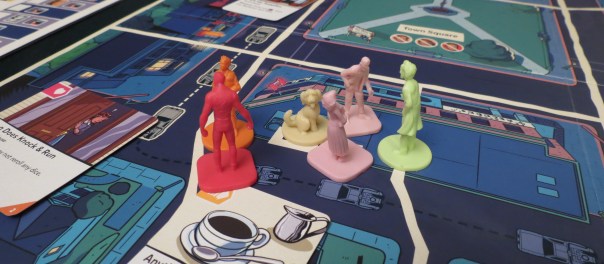
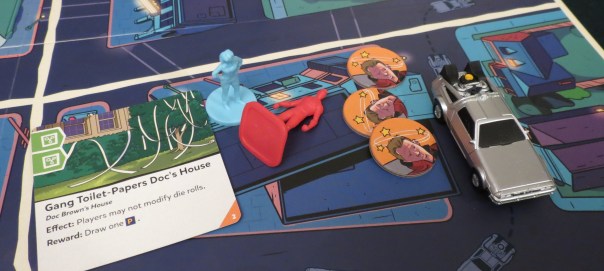
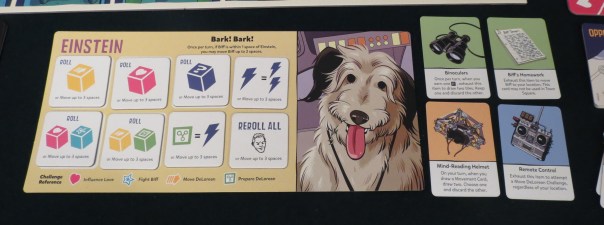
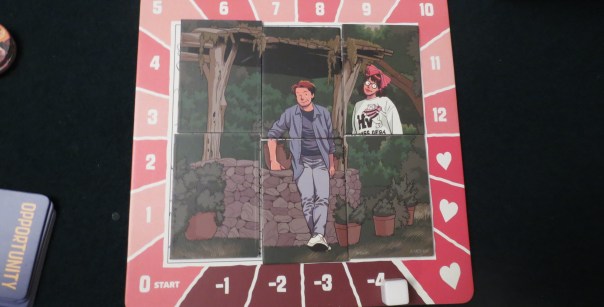
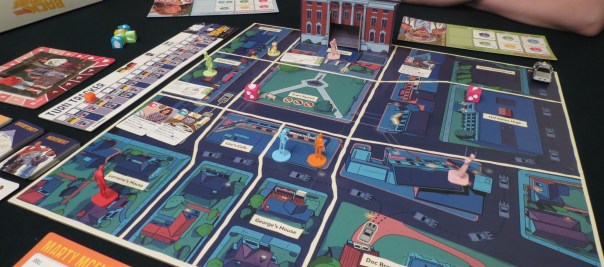
Somehow I am a bit surprised that you reviewed this one, but it was a pleasure to read!
Why are you surprised, Alexandre? I’m a certified fan of Prospero Hall!
Pingback: Review: Back to the Future: Back in Time:: Back to the Universal Studios Licensed Property (a Space-Biff! review) – Indie Games Only
Pingback: Review: Back to the Future: Back in Time:: Back to the Universal Studios Licensed Property (a Space-Biff! review) – Indie Game News